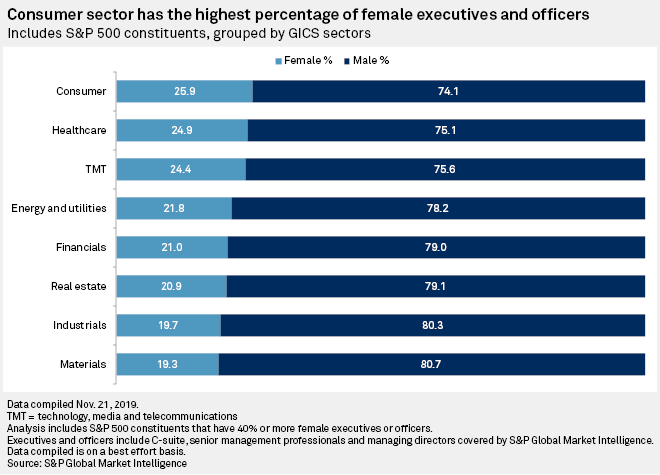There are just three companies in the S&P 500 where a majority of senior executives and officers are women, a new S&P Global Market Intelligence analysis finds.
The analysis included S&P 500 constituents as of Nov. 20, 2019. It found that the consumer sector has the highest percentage of women in senior roles, at 25.9%. The healthcare sector followed closely, with 24.9% of executive and officer roles held by women.
The figures illustrate the difficulty companies face when aiming to enlist a majority of women in their top ranks, or even reach gender parity among senior leaders. Finding female candidates with the right set of experiences in a given industry can be a daunting task, though the success of several companies in the index shows it can be done.
"Our job is to find the needle in the haystack — those very, very few that are as close as possible" to a role's listed requirements, said Becky Heidesch, founder of WSS Executive Search, a recruitment firm specializing in placing senior level women and diverse executives.

There is no perfect definition of what constitutes a senior role. For the purposes of this analysis, S&P Global Market Intelligence considered positions with the words "senior," "chief," "managing director," "head," "president" or "key," plus any positions with the word "director." The analysis focused on management roles and did not include board directors.
The composition of a company's overall workforce matters when it comes to increasing the number of upper-level female executives. A 2019 International Labour Organization, or ILO, report on women in business and management surveyed nearly 13,000 enterprises across 70 countries and highlighted the importance of a pipeline to build skills and experiences that boards and committees expect senior leaders to bring to the job. On average, ILO found that the higher the proportion of female employees, the greater the probability that women will be in management.
But even when women ascend to more senior roles, research shows that these positions are more frequently in support management functions like human resources, administration and marketing as opposed to more strategic ones. The ILO report highlighted the impact of this "occupational segregation."
"[M]en are over-represented in operations, research and development, and profit and loss management functions that are considered to be more strategic for enterprises and can often be a springboard to CEO or board-level positions," ILO wrote. "This confirms that so-called glass walls result in gender segregation in management functions, limiting the talent pool enterprises are able to tap into for candidates to fill top executive and CEO positions."
The ILO study also found that enterprises with more female employees are significantly more likely to have a woman as CEO. That is the case at cosmetics giant Ulta Beauty Inc., which topped the S&P Global Market Intelligence analysis with women in 71% of senior roles.
Illinois-based Ulta opened in 1990 and now operates more than 1,200 retail stores across 50 states, where it sells beauty, fragrance and skin care products and offers salon services. The company has 45,000 associates, and 92% of them are women.
The analysis identified just two other companies where a majority of senior roles are held by women — biotechnology firm Alexion Pharmaceuticals Inc. and W.W. Grainger Inc., which distributes maintenance, repair, and operating products and services. At year-end 2019, 53% of Alexion's 3,082 full-time employees worldwide were women, according to a company spokeswoman. W.W. Grainger's corporate social responsibility report for 2019 stated that about 38% of its 24,000 employees are women, and 31% are women in leadership positions.
Four other companies in the analysis had an even 50% split of men and women in senior roles.

Big investors are paying increasing attention to environmental, social and governance issues like diversity. BlackRock Inc. and State Street Global Advisors, two of the world's largest asset managers, have urged their portfolio companies to promote women and minorities within their ranks and increase gender diversity on their boards.
Corporations are taking notice too. In January, Goldman Sachs Group Inc.'s CEO said the company will stop underwriting initial public offerings for companies that do not have at least one diverse board member. Companies are increasingly focused on developing a pipeline of women for senior positions, WSS Executive Search's Heidesch said.
"This last year more than any other year we have been contacted regarding that topic," Heidesch said in an interview.
WSS works with client companies to identify areas where they can be flexible in their job descriptions. When a company in a male-dominated industry wants to fill a senior role, the list of qualifications often rules out women. For example, companies might seek an individual with experience managing 1,000 people and a $500 million direct profit & loss statement.
"We're always going to find the white Caucasian male that's going to match up to that because they have predominantly done that work and been in that role and moved up in those management and budgetary kind of roles and leadership roles," Heidesch said.
Even companies with a stated commitment to diversity sometimes balk at the extra time, money and effort that goes into recruiting female candidates.
"We're in a very dynamic culture today — we've got to fill the position as soon as possible, nobody wants to lose a day in business,” Heidesch said. Qualified female candidates are at a premium in the marketplace today, Heidesch said, so companies need to proactively develop a pipeline of external as well as internal candidates instead of waiting until the last minute.
"You're going to have to lure them away. There's going to be this time period of building a relationship," she said. "Executives don't just jump ship quickly."



